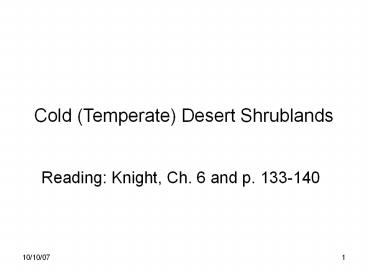Cold (Temperate) Desert Shrublands PowerPoint PPT Presentation
Title: Cold (Temperate) Desert Shrublands
1
Cold (Temperate) Desert Shrublands
- Reading Knight, Ch. 6 and p. 133-140
2
Climatic conditions
- Warm deserts grade up into cold deserts, with
some overlap in species (figure from UNLV up) - Cold desert shrublands may receive less precip
than warm deserts, but have lower evaporation
rates, hence higher P/E ratios - Warm desert P/E averages 0.3
- Cold desert P/E about 0.5-0.7
- Much precip falls as snow, melts in spring and is
stored in soil profile snow distribution
patterns play a major role in vegetation mosaic - Elevation range 1000 meters to lower treeline
3
Warm desert grades up into cold desert in the
Great Basin
4
Not all cold desert ecosystems are the same
- Intermountain basins west of the Great Plains are
dominated by shrublands - Sagebrush vegetation types are most common
- Historically there were 44 million ha of
sagebrush (West and Young 2000) - largest semi-arid ecosystem in North America
(10 of land area) - Saltbush-greasewood vegetation
- Saline areas
- 17 million ha
5
Halophytic shrublands
- Many basins and playas have haloseres,
following gradients of soil salinity and water
table depth - Most saline/shallower water table
- Saltwort gt inland saltgrass, alkali sacaton gt
greasewood gt saltbushes, kochia gt winterfat gt
horsebrush gt sagebrush - Least saline/deeper water table
6
Two subdivisions of sagebrush vegetation type
Sagebrush ecosystems have different properties,
depending on their species composition, stand
structure, and age
After Kuchler 1970
7
Two subdivisions of sagebrush vegetation type
- Sagebrush steppe moister, contains codominant
bunchgrass component, greater biodiversity - Sagebrush steppe was once more extensive has
been converted to farmland or degraded by
excessive grazing - More pristine sites have up to 80 cover, with
microphytic crust of lichen, algae and moss - Sagebrush steppe evolved with browsers such as
Shasta ground sloth, mastodon, and camels, which
disappeared 12,000 BP
8
Sagebrush steppe near Casper
- Rapid recovery from fire if perennial grasses are
well established - Cheatgrass invasion after wildfires but not after
prescribed burning in spring
9
Two subdivisions
- Great Basin Sagebrush more arid, more bare
ground, fewer taxa with more intraspecific
variation - More cool-season grasses in western part of
range, more warm-season sod-forming grasses in
eastern part of range - Islands of fertility have developed, with much
lower grass cover between shrubs herbs grow
under shrubs, nutrients accumulate there - Great Basin sagebrush type is thus more
susceptible to erosion and degradation than
sagebrush steppe
10
Great Basin sagebrush and cheatgrass invasion
Great Basin sagebrush communities take gt 10 years
to establish after a disturbance. When cheatgrass
invades, fire frequency increases and may prevent
sagebrush re-establishment.
11
(No Transcript)
12
Big Sagebrush Range
The dominant shrub across the intermountain west.
Why?
13
Some sagebrush drought adaptations
- Artemesia leaves are very hairy
- Also seasonally dimorphic
- Spring leaves are large, fall off when soil dries
out - Early summer leaves are small, persist through
winter - Photosynthesis occurs during winter
- A. tridentata has 2 root systems taproot for
obtaining deep water shallow, fibrous roots for
rapid acquisition of nutrients and water - Plant hydraulics small xylem vessels, low water
potential, high resistance to cavitation
14
Leaf cross-section
Stem cross-section
Stomate with lots of flat hairs
Stem cross-section w/xylem and phloem
Photomicrographs courtesy of Kusum Naithani
15
More Sagebrush Adaptations
- Seedling recruitment is likely to coincide with
wet episodes - Plants are long-lived (100 years or more) but
most species do not resprout after burning - Is sagebrush r-selected or K-selected?
- Terpenes reduce herbivory defenses
- Terpenoids are qualitative and not quantitative
defenses - Livestock avoid sagebrush but native ungulates
utilize for winter browse
16
Sagebrush species groups
- Two main groups of sagebrush species tall and
low - Different species can be segregated along soil
moisture and temperature gradients - Seedling establishment is critical in determining
distributions - A. tridentata ssp. wyomingensis seeds germinate
readily in moist hollows in early spring, but not
if any salts are present - Many dont survive the dry summer
- 6 months later, no viable seeds are present
17
Ordination of major sagebrush types against
elevation and moisture gradients (Knight, 1994,
Fig. 6.3)
18
Distribution of sagebrush species in Wyoming
Artemisia tridentata (big sagebrush) is the most
widely distributed, with 3 main subspecies
19
Big Sagebrush Subspecies
- There are three subspecies of sagebrush found
along elevation and moisture gradients - Morphological and physiological differences are
maintained in common garden experiments - Wyoming big sagebrush (spp. Wyomingensis)
- Consistently tetraploid
- Low elevation and dry end of moisture limit
- Basin big sagebrush (spp. tridentata)
- Diploid or tetraploid
- Intermediate elevation and moisture limit
- Mountain big sagebrush (spp. vaseyana)
- Consistently diploid
- High elevation and moisture limit

